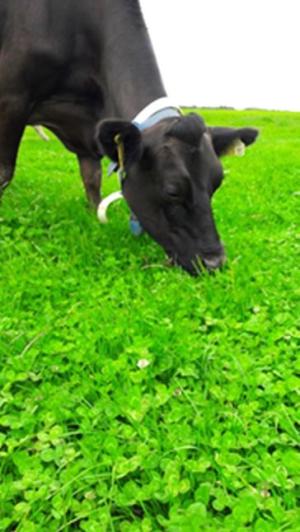Mixed Swards Make More Milk!
Date published:
The ability of white clover to fix atmospheric nitrogen and drive extra herbage production at low nitrogen levels has been known for a long time and particularly on organic farm systems. However, at high nitrogen levels many farmers assume there is little benefit.

To challenge this assumption a dairy grazing project was set up in Clonakilty, Co Cork to analyse the effect of sward type on grass and milk production. This project was part of the AFBI-Teagasc-QUB PhD programme focusing on improving grassland production in Ireland. This article reports the animal production side of the grazing study while another article in this series from Dr Clare Guy will discuss the herbage production and sward characteristics of the study.

Milk yield, milk composition, body condition score (BCS), bodyweight and fertility performance were all recorded. Milk yields were recorded twice daily and sampled every week on a consecutive evening and morning milking. BCS and bodyweight was recorded every second week and fertility performance was based on scanning results and breeding records. All cows were fed the same amount of concentrate, at an average of 343 kg concentrate/cow/year over four years.
So which farmlet produced the most milk?
Surprisingly there was very little difference between the diploid and tetraploid swards for total milk production and no differences in bodyweight, BCS or fertility performance. This similarity in milk yields was unexpected as tetraploids are well known to be more palatable and digestible than diploid swards and often support better milk yields and composition. These pure grass swards produced 5,217 kg milk/cow/year and 437 kg milk solids/cow/year. However, the grass/white clover swards produced 5,825 kg milk/cow/year and 485 kg milk solids/cow/year. This gave a huge difference of 608 kg milk/cow/year and 48 kg milk solids/cow/year for cows that grazed on grass/white clover swards. The grass/white clover swards also had a higher protein and dry-matter digestibility compared to the pure grass swards and this difference was also found in the silage bales produced from each farmlet.
How can you manage white clover swards?
White clover is clearly a very different plant to perennial ryegrass, with a different growing habit. Clover has a lower winter growth rate, but has a much higher growth rate in summer and autumn. This means grass/clover swards often have a lower opening farm cover in spring but shorter rotations in summer, due to the extra forage being produced. In Clonakilty we noticed that after the first grazing in spring, the grass/clover swards matched the pure grass sward growth rates from then onwards but needed this first grazing to kick-start growth. As white clover has high protein and is highly digestible, there is a risk of bloat, but only when sward clover content is high (typically over 40%). To prevent bloat occurring cows were given bloat oil or 12 hour grazing breaks to prevent them from selectively grazing white clover. This was only necessary in a small number of paddocks and typically only in late summer when clover content was at its highest.
So what did we learn from this study?
It is obvious there can be huge production benefits to having white clover in swards. Cows on the grass/clover farmlets produced much higher milk yields at a similar milk composition such that their total milk solids production was higher than from the grass only swards. In financial terms, at a milk solids price of €4 per kg, this extra milk solids production is worth €192 per cow per year. This shows the huge potential of grass/clover systems even for intensively managed farms. Alternatively there is potential to reduce nitrogen fertiliser application costs on farm by allowing biological nitrogen fixation by white clover. If farmers manage clover swards correctly it is clear that fertiliser inputs can be reduced while also increasing milk outputs, thereby making intensive systems more sustainable and profitable for the future.
Over the next few weeks we will continue to release the remaining four in this series of articles on practical solutions to grassland farming as identified through a highly successful partnership between AFBI, Teagasc and QUB over the past number of years.
You can continue to read about some of the key findings from some of these PhD programmes through short overview articles in the press and on the AFBI website (www.afbini.gov.uk).
The next article in the series from Clare Guy reveals how white clover can enhance grazed grass production. This will be followed by Nicky Byrne who informs us about ‘what cows want’ from a grass-based system, Stephen McAuliffe reports the benefits of grass-clover swards at the farm system level and finally Thomas Tubritt concludes the series of articles by revealing that cows have preferences for different grass varieties.
A mark of success of the PhD programme is evidenced by how these students are now taking their knowledge and skills into agricultural research or into key support roles for the agricultural industry.
Notes to editors:
AFBI-Teagasc-QUB Partnership: This is the first in a series of five PhD student articles revealing how this teaching partnership is creating new knowledge and the next generation of grassland experts, to support grass-based farming across Ireland.AFBI is an arms-length body of DAERA delivering research and development, diagnostic and analytical testing, emergency response capability and expert scientific advice for DAERA and other government departments, public bodies and commercial companies in Northern Ireland, and further afield.AFBI’s Vision is “Advancing the Local and Global Agri-Food Sectors Through Scientific Excellence”.AFBI’s core areas:- Leading improvements in the agri-food industry;- Protecting animal, plant and human health;- Enhancing the natural and marine environment.